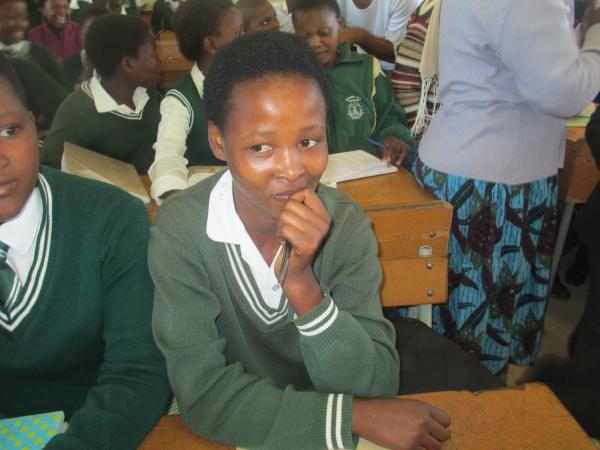

Grade 9 learner Athini Maphini is one of 110 learners in a classroom at Putuma JSS. Photo by Mary-Anne Gontsana.
25 April 2013
Equal Education has organised a two-day “solidarity visit” of schools in the Eastern Cape. Well-known South Africans, including Archbishop Thabo Makgoba and constitutional law blogger Pierre De Vos, are participating. GroundUp journalist Mary-Anne Gontsana is also taking part, reporting what she sees. Here is her first report.
An Equal Education pamphlet says, “The 2013 draft norms and standards fail to specify the amount of learners per classroom or the size of classrooms. Nothing in the draft addresses the problem of overcrowding or learner to teacher ratio.” An example of what the organisation means is the grade 9 class of Putuma Junior Secondary School (JSS) in the Mbhashe municipality in the Eastern Cape.
Athini Maphini is a Grade 9 learner at Putuma, she is part of a class of 110 learners. “We are packed here in our social sciences class but there is nothing we can do about it.”
Deputy Principal of the school, Zukile Gana said overcrowding and lack of accommodation for the learners are their biggest problems. “We have 24 educators including myself and the principal and 1,175 learners enrolled. This no fee Grade R to 9 school was established in 1905. It was attached to a church but as it grew it was then built here, separately.”
Walking into the packed classroom, I was told that even though it was full there were a some students absent because they lived too far or because of floods caused by heavy rains on the weekend. “School starts at 7.45am but since it was raining many learners did not show up because when it rains, they are forced to cross rivers to get here. Some parents organise transport and some just cannot afford it,” said Gana.
Maphini walks to school in a group of three other learners, and it takes her an hour to get to school. She wakes up at 4am every morning and is lucky if she gets to school before 8am. “Some of the others bring umbrellas, which helps, but otherwise we arrive in class soaking wet and our uniforms dry on us.”
In one of the classrooms, learners were sitting on concrete building blocks and using them as desks because of lack of furniture and overcrowding. Grade 8 is a little better. There are about 60 learners in a classroom. They are provided food from a makeshift feeding scheme.
Not far from Putuma JSS is another school in need of proper classrooms and furniture, Sea View Senior Secondary. This Grade 10 to 12 high school has 278 learners and eight educators of which only two are permanent.
Sea View principal Vukile Masinyana said the two teachers were himself and Lindeka Sombeselele who was not being paid for the work that she does. “There is no deputy principal and the educators are volunteers. The school was established in 1995 and right now it is still in phase 1. We have been waiting ever since for the next phase to continue. We are struggling to raise funds to finish a building which we want to turn into a classroom.”
As I walked into a Grade 12 classroom which is a hall separated by a broken wooden sliding door, volunteering business studies teacher, Bongeka Bhungane, was writing down the contents of a textbook on the blackboard because there were no textbooks available for the learners to use.
“You find at times that there are only three textbooks in the whole of Grade 12,” said Sombeselele. Last year the school had a 13 percent pass rate due to shortage of teachers. One Grade 11 classroom had no educator because she left after not getting paid.
These two visits are part of a solidarity visit by Equal Education, who after a two year campaign succeeded in getting Basic Education Minister Angie Motshekga to publish binding Minimum Norms and Standards for School Infrastructure. These regulations, due to be published on 15 May 2013, will set a minimum school infrastructure standard that all schools will have to meet. If schools don’t meet the standards then, at least in theory, communities will be able to hold government accountable.
Also see: Why do learners have to use toilets that look like this?